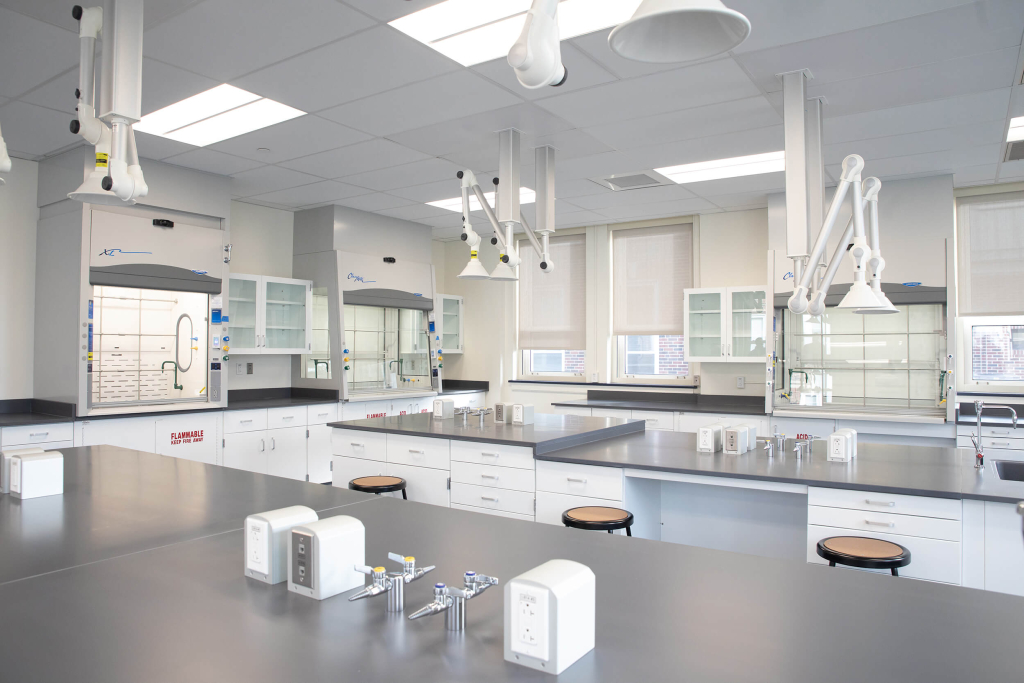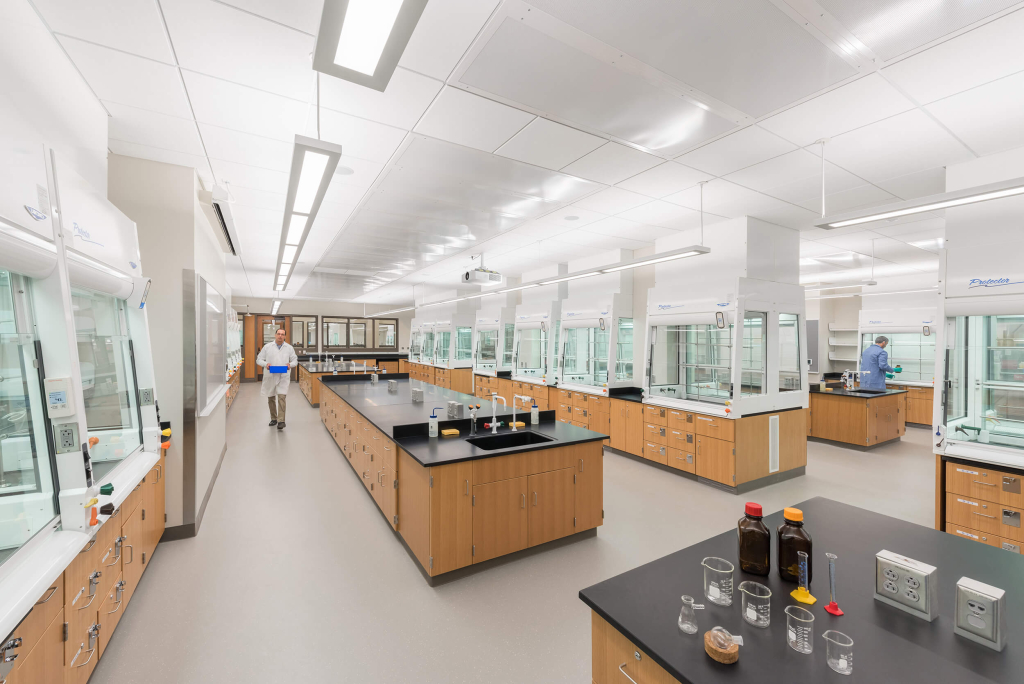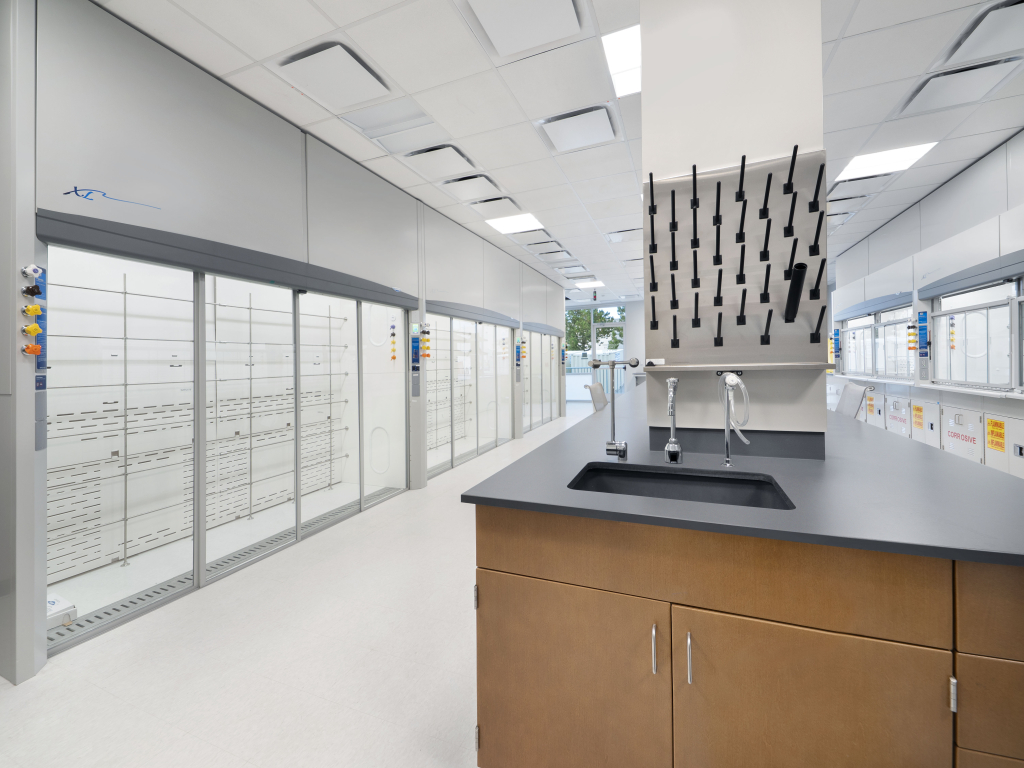Laboratory Fume Hoods: Planning for Safety

Protector XL and ClassMate Benchtop Fume Hoods in a general chemistry lab at Penn State Schuylkill.
The more you look at the options for your new lab space, the more you will realize that the possibilities are truly endless. Designing a new lab space or renovating an existing lab requires special attention to detail from start to finish.
Your new lab will have various design considerations including new cabinetry, equipment and furnishings to go along with a specialized mechanical system, plumbing and a network of electrical requirements. Many of these are straight forward decisions, but fume hoods are one of the only pieces of equipment found in new labs that will have an impact on almost every design decision. If your lab has specific applications that require using a fume hood, getting the fume hood integration right is a top lab safety design consideration. In this article we will discuss the responsibilities in lab planning, important items to highlight when determining fume hood placement and address what type of fume hood is needed for your lab’s specific application needs
Chemical Hygiene Plan
When developing a strategy to accommodate the safety needs of your laboratory, the Chemical Hygiene Plan (CHP) is the first and most important place to start. According to the Code of Federal Regulations (CFR 29 1910.1450) the CHP is, “…a written program developed by the employer which sets forth procedures, equipment, personal protective equipment and work practices that are capable of protecting employees from the health hazards presented by hazardous chemicals when used in that particular workplace.” The CHP is required by the Code of Federal Regulations “…where hazardous chemicals… are used in the workplace” and is the responsibility of the facility. This document is required by law, put together by performing a thorough risk assessment for the practices in a lab, and will conclude with guidelines for all laboratory equipment, including fume hoods, to ensure the safety of laboratory personnel. The CHP should contain information discussed in the following sections of this article and in turn will be an excellent resource guide for any lab as a robust safety document.
Importance of Fume Hood Placement

Teaching lab full of Protector ClassMate Fume Hoods at Yale University. ® Anton Grassl/Esto
The placement of a fume hood in a lab can significantly impact the overall lab layout. Fume hoods are safety containment devices that offer protection to laboratory personnel who are handling potentially dangerous fumes, vapors and aerosols and they do this simply by the movement of air through the hood interior. For this reason, doorways, high-traffic walkways, supply air registers and even the placement of other hoods must be considered when placing a new fume hood. All these factors can affect the level of protection the fume hood will offer.
Exposure Control Technologies, Inc. (ECT, Inc.) published a resource titled Laboratory Airflow Distribution that is an excellent reference document for anyone planning a lab space with a focus on fume hood placement. This guide highlights several key pieces of information that will allow you to avoid unnecessary lab planning problems.
First, avoid placing a fume hood next to a doorway. Not only do doors provide a location for heavy foot-traffic, but adjoining rooms are often pressurized differently. The opening and closing of these doors can cause complications for a fume hood if it is not placed at a safe enough distance away.
Next, fume hood sash openings should be a safe distance away from high-traffic aisles in your lab. This not only creates a safer working environment for any personnel working inside the hood, but also helps avoid exposing fume hoods to turbulent air created by the movement of bodies, which could cause containment loss of hazardous fumes.
Every lab needs air to be directed into the space, but plan to have air supply registers at a proper distance away from the fume hood opening. Air from these registers often moves at a high rate of speed and can easily disrupt airflow inside a fume hood. Planning for these registers to be placed in a more optimal location will ensure the fume hood is able to maximize containment as designed.
Finally, be sure to consider where other fume hoods will be placed in the lab space. If fume hoods are placed facing each other, they could be competing for air and one, if not both, of the hoods may not be getting the required amount of air it needs to perform safely and effectively. Proper placement of fume hoods, and other equipment for that matter, will help ensure the safety of everyone in your lab.

Protector XL Floor-Mounted and Benchtop Fume Hoods in a research lab for one of Labconco's pharma clients.
Define the Type of Fume Hood
Determining the proper type of fume hood needed for a new lab space is equally as, if not more, important as determining where it is going to be placed. Different applications may require a certain type of fume hood based on what is being done in the hood and what materials will be handled in it. Selecting the appropriate fume hood type ensures that the users will be safe, sensitive equipment will be protected, and the fume hood will last. For certain procedures, such as ones including the use of perchloric acid or radioisotopes, this becomes a straightforward decision — you need a fume hood specialized for those applications. For other procedures, it may require a little more research and consultation.
Start by thinking of dimensional requirements for the hood. This could be determined by the size of a lab, or the size of equipment to be placed inside the fume hood. Keep in mind that fume hoods are typically very large and tall pieces of equipment that are placed on top of cabinetry, so labs with short ceilings may require a fume hood designed for smaller spaces.
Equipment that will be used within a hood also play a big role in the size of fume hood required. For instance, you should typically account for six inches of clearance in the front and back of the piece of equipment to promote proper airflow within the interior of the hood. If the equipment placed in the fume hood is large, the hood needs to be deep enough to safely house it.

Protector XStream Fume Hoods in Wellesley College Science Center on Science Hill. These hoods were painted with Wellesley Blue to help students gain a better understanding of the differences between the types of fume hoods in the lab space.
In addition to dimensional requirements, materials of construction are key to having a fume hood that will last. Before deciding on a fume hood, make sure the chemicals you will be using are compatible with the hood’s materials of construction. For instance, if your lab is using nitric acid, avoid selecting a hood that has an interior composed of coated steel. Instead, look more towards a fiberglass polyester or PVC lined fume hood designed to withstand chemical reaction. Improper planning on the type of fume hood and its material of design can lead to corrosion inside the hood and a premature need to replace it.
Finally, in many lab spaces, emphasis is placed on fume hoods that operate using less air than conventional hoods. These are called high performance fume hoods and they can serve many purposes, such as helping a lab meet various sustainability requirements, or replacing a hood in an old lab where there are limits on how much air can be exhausted. If your lab has these types of requirements, you will need hoods that contain at a high level with reduced air volume as other types of hoods may not offer sufficient protection. Every lab is different, so identifying the correct type of fume hood for your lab’s needs will go a long way in providing the safest environment possible.
With all the details to consider, the process of designing a lab that includes fume hoods can feel like an uphill battle. After all, the fume hood needs to be properly integrated to offer optimal protection to those who will be using it. Getting ahead of the planning by outlining a CHP and defining what your lab needs to be safe is the only way to proceed. It will make the process simpler and maximize the safety in your laboratory environment.
Labconco offers a variety of fume hood options that can integrate into any lab setting including: chemical hoods, educational hoods, filtered hoods, floor-mounted hoods and hoods for special applications using perchloric acid, acid digestion and radioisotopes. Check out Labconco’s Fume Hood Selection Guide to find the perfect fit for your laboratory's applications.
| chevron_left | Finding A Balance – Engineering Ergonomics for Microbiological Safety Cabinets | Articles | Pharmacy IV Workflow Integrated Biosafety Cabinets | chevron_right |






